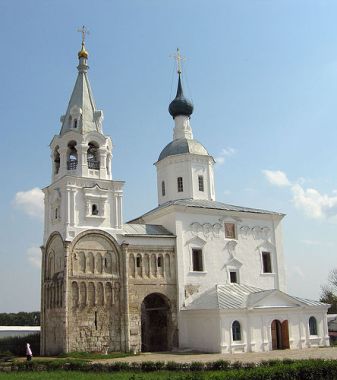

Constructed: 12 century
The Cathedral of the Nativity of the Blessed Virgin Mary is a prominent Russian Orthodox church located within the Holy Bogolyubovo Convent in the settlement of Bogolyubovo, Vladimir Oblast, Russia, about 10 kilometers northeast of the city of Vladimir. Situated on a high bank overlooking the confluence of the Nerl and Klyazma rivers, it forms part of a historic monastic complex that traces its roots to the 12th century and is recognized as a UNESCO World Heritage Site under the "White Monuments of Vladimir and Suzdal" designation since 1992. The site blends ancient architectural remnants with later reconstructions, reflecting centuries of religious, cultural, and political significance in Russian history.
The origins of the cathedral and the surrounding complex date back
to 1158–1165, when Prince Andrei Bogolyubsky (Andrei the
God-Loving), a key figure in the rise of the Vladimir-Suzdal
principality, established his princely residence here. According to
Russian Orthodox tradition, Andrei chose this location after
experiencing a miraculous vision of the Theotokos (the Virgin Mary)
while traveling from Vyshgorod to Rostov. In the vision, she
commanded him to build a church and monastery on the spot, and he
commissioned an icon depicting the apparition, known as the
Bogolyubskaya Icon of the Theotokos, which became a revered relic.
The settlement was named Bogolyubovo, meaning "God-loving," in honor
of this event.
The original Cathedral of the Nativity was
constructed as the centerpiece of Andrei's fortified palace, which
included ramparts, moats, walls, towers, and connecting passages.
Andrei was murdered in 1174 by conspirators in one of the palace's
staircase towers, an event that led to the abandonment of the
residence as a princely seat. A monastery was soon established on
the site, and the area became a pilgrimage destination tied to
legends of the Virgin's appearance, the Vladimir Icon of the Mother
of God, and Andrei's canonization as a saint in 1702. The complex
suffered damage during attacks, including by Gleb of Ryazan in 1177
and Mongol invasions in the 1230s, which destroyed much of the
fortifications.
By the 18th century, the original cathedral had
fallen into disrepair and partially collapsed in 1722. It was
rebuilt in 1751, incorporating surviving 12th-century fragments such
as the basement, a spiral staircase, and a gallery from the palace
tower where Andrei met his end. These remnants were preserved after
his canonization, using stones from the ancient structures. The
monastery gained prominence as a patriarchal residence in 1687 and
was visited by numerous Russian rulers, including Tsars Fyodor
Alekseevich, Peter I, Paul I, Alexander I, Alexander II, and the
family of Nicholas II in 1913. It became a synodal monastery in 1753
but was closed by Soviet authorities in 1923, with its buildings
repurposed for secular uses like schools, hospitals, and warehouses.
Restoration began in the 1990s after parts were returned to the
Orthodox Church in 1991 and 1997, leading to the establishment of
both male and female monastic communities. Active rebuilding and
preservation efforts continue today, with the site attracting
pilgrims and tourists.
The current Cathedral of the Nativity, dating primarily to 1751, is
a Baroque-style structure built on the foundations of the
12th-century original. It integrates pre-Mongol elements, making it
a unique blend of medieval and later Russian architecture. The
exterior features white stone walls typical of the Vladimir-Suzdal
school, with a tent-shaped bell tower added over the preserved
staircase tower in the 18th century. This tower, a two-tiered
structure with a connecting passage, is the oldest surviving example
of pre-Mongol Russian secular (civil) architecture and serves as a
poignant reminder of Andrei's palace. The interior, though
reconstructed, echoes the opulence of the original: historical
accounts describe the 12th-century version as adorned with limestone
reliefs, frescoes, copper-gilded details, ceramic floors, stained
glass, marble-like plaster on columns and the dome, and a limestone
holy water basin at the entrance.
The cathedral is part of a
larger ensemble within the Bogolyubsky Monastery, which includes:
Remains of Andrei Bogolyubsky's Palace (1158–1165): Fragmentary
walls and the aforementioned staircase tower.
Annunciation
Refectory Church (1683, rebuilt 1804): A smaller church used for
monastic dining and services.
Cathedral of the Bogolyubsky Icon
of the Mother of God (1866): A later addition dedicated to the
site's foundational icon.
Bell Tower with Church of the
Assumption of the Blessed Virgin Mary (1841–1842): A prominent
structure with integrated chapel.
Civic Chapel (17th–19th
centuries) and various cell enclosures, fences, and towers from the
18th–19th centuries.
Nearby, about 1–2 kilometers away in the
water meadow below the hill, stands the related Church of the
Intercession on the Nerl (1165), also commissioned by Andrei
Bogolyubsky. This single-domed white-stone church, often hailed as a
masterpiece of Russian architecture for its harmonious proportions
and intricate carvings, was built to commemorate a military victory
and the death of Andrei's son. It is closely tied to the Bogolyubovo
complex and shares its UNESCO status, though it is a separate
structure.
As a key site in the Golden Ring of Russia—a route of ancient towns
northeast of Moscow—the Cathedral of the Nativity symbolizes the
transition of political and cultural power from Kiev to the
Vladimir-Suzdal region during the medieval period. It embodies the
fusion of princely authority and Orthodox piety, with Andrei
Bogolyubsky's legacy as a saint and builder underscoring themes of
divine intervention and martyrdom. The Bogolyubskaya Icon, housed in
the complex, remains a major pilgrimage draw, associated with
miracles and protection.
Today, the convent operates as an active
nunnery, with the cathedral serving both religious and museum
functions (managed in part by the Vladimir-Suzdal Museum-Reserve).
Visitors can explore the grounds, though access to certain areas
like the staircase tower may be restricted. The site highlights
Russia's architectural evolution from pre-Mongol white-stone mastery
to Baroque revivals, and its preservation efforts reflect
post-Soviet revival of Orthodox heritage. Note that the monastery
often closes earlier than posted hours (typically until 6 PM on
weekends), so plan visits accordingly.